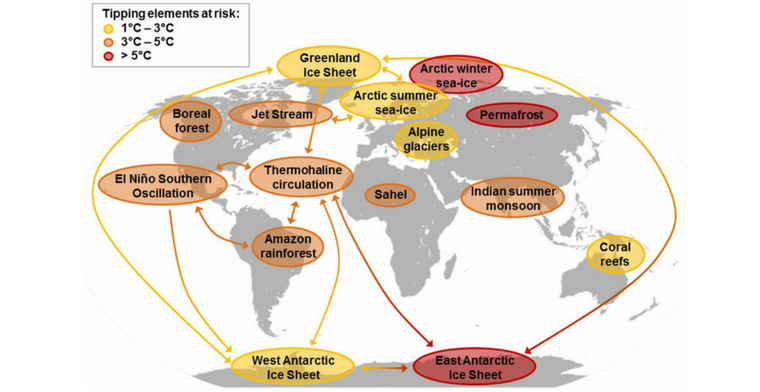By: Anne Rinaudo
An international study has found the Earth is at risk of entering a hothouse climate that could lead to global average temperatures of up to five degrees Celsius higher than pre-industrial temperatures and long-term rises in the sea level of between 10 and 60 metres.
Lead researcher, Professor Will Steffen, Fenner School of Environment and Society, ANU College of Science, says such increases in temperatures and sea level would be devastating for human civilisation and most ecosystems that support plant and animal life. Professor Steffen walked Open House through the science.
Wildfires, drought and heatwaves
California and Greece have recently experienced unprecedented wildfires, Europe is in the grip of a prolonged heatwave and NSW and Queensland are experiencing drought at a level not seen for a generation. Professor Steffen says these are similar to the types of processes the researchers talk about in the paper ‘Trajectories of the Earth System in the Anthropocene’.
The California wildfires, for instance, followed the worst drought in 1,200 years. In a report about Australian firefighters flying to the US to assist with the massive and unpredictable wildfires a professor from the University of California warned “Wildfires are responding to climate change and climate change is accelerating. It will continue to evolve throughout the lives of everyone now alive on the planet. No one alive today will ever see a stable climate system again. If we continue to emit greenhouse gas pollutants, climate change will be even more severe later in the century.”
Professor Steffen points out that “…increasing wildfires, particularly in the vast boreal forests of Canada and Russia, comprise one of the feedbacks/tipping points that we include in our analysis.”

Uninhabitable for humans
“The current efforts by nations, which are not sufficient to meet the emission-reduction targets set in the Paris Agreement a few years ago, are unlikely to help us avoid this very risky situation, where many parts of the planet could become uninhabitable for humans,” says Professor Steffen.
Global average temperatures are just over one degree Celsius above pre-industrial temperatures and rising at 0.17 degrees Celsius each decade.
Temperatures rising
“Human emissions of greenhouse gas are not the sole cause of temperature changes on Earth. Our study indicates that human-caused global warming of two degrees Celsius may trigger other Earth System processes, often called feedbacks, that can trigger further warming – even if we stop emitting greenhouse gases.”

Glacier watch
Recently returned from a trip to South America, Professor Steffen says the signs of global warming are all around us. The Andes glaciers, for instance, are melting all up and down the lengthy mountain chain.
He recounted that above Huaraz, Peru, near to Huascaran, the highest mountain in Peru, there was such concern about the rapid rate of ice loss that a person was stationed near an ancient glacier twenty four hours a day, seven days a week. Their job was to sound a warning if the ice dam holding back the glacier failed. People lower down the mountain would have just half an hour to evacuate.
Critical tipping points “like dominos”
Professor Steffen said nations needed to work together to greatly accelerate the transition towards an emission-free world economy. Researchers from Australia, Sweden, Denmark, the United Kingdom, Belgium, the United States, Germany and the Netherlands contributed to the study, which is published in the prestigious international journal PNAS. The authors of the study considered 10 natural feedback processes, some of which are tipping elements that lead to abrupt change if a critical threshold is crossed.
“The real concern is these tipping elements can act like a row of dominoes. Once one is pushed over, it pushes Earth towards another. It may be very difficult or impossible to stop the whole row of dominoes from tumbling over,” Professor Steffen said.
Domino effect
Such a feedback cascade could trigger the uncontrollable release into the atmosphere of carbon that had been previously stored in the Earth. The feedbacks are illustrated in the in the diagram below. They are:
- permafrost thaw
- loss of methane hydrates from the ocean floor
- weakening land and ocean carbon sinks
- increasing bacterial respiration in the oceans
- Amazon rainforest dieback, boreal forest dieback
- reduction of northern hemisphere snow cover
- loss of Arctic summer sea ice and
- reduction of Antarctic sea ice and polar ice sheets.

NASA’s Earth Observatory has many global maps and images with time lapse presentations of changes in rainforests, river deltas, Arctic and Antarctic sea ice, global temperature and other factors Dr Steffen’s team looked at.
Listen: Will Steffen in conversation with Stephen O’Doherty.
Article supplied with thanks to Open House.
Anne is the producer of Open House – a weekly three-hour live talkback radio show exploring life, faith and Hope from a Christian perspective.
